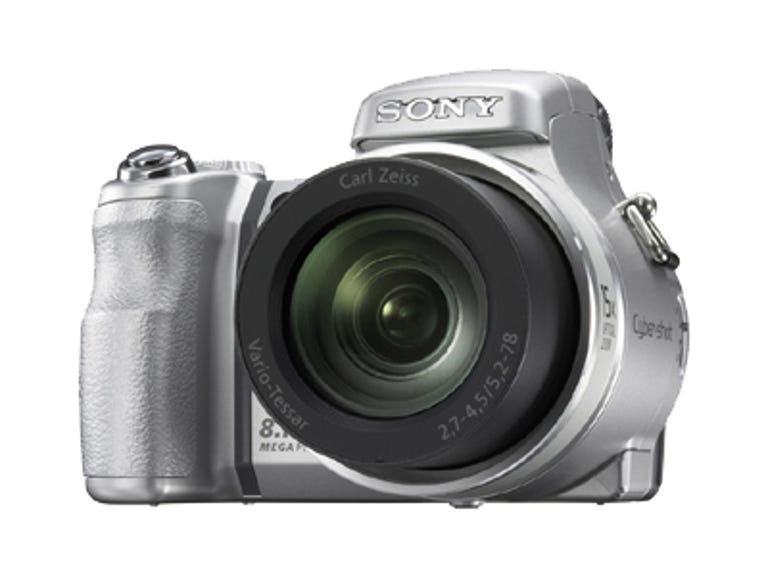 Why You Can Trust CNET
Why You Can Trust CNET Sony Cyber Shot DSC-H9 review: Sony Cyber Shot DSC-H9
Sony Cyber Shot DSC-H9
The Good
The Bad
The Bottom Line
Sony changed quite a few details, inside and out, between last year's H5 and its latest megazooms, the Cyber-shot DSC-H9 and DSC-H7. An f/2.7-4.5 31mm-465mm 15x supersedes the 12x zoom on last year's, and the resolution kicks up a notch from 7 to 8 megapixels. Say goodbye to AA batteries and hello to a proprietary lithium ion.
Two features differentiate the H9 and H7: The H9 retains the same excellent 3-inch flip-up LCD as the H5, while the H7 uses a fixed 2.5-inch version, and the H9 includes Sony's NightShot infrared mode. They are otherwise identical, and we expect the same performance and photo quality. We tested the H9.
The plastic body feels a bit cheap, and the grip--a bit larger than the H5's--could use more of a rubbery texture. Sony also "improves" upon the simple 4-way-plus-set navigation controls of the H5 by adding a scroll wheel and now-Sony-standard Home and Menu buttons. I love the scroll wheel, but it takes a little while to get used to the operation for adjusting shooting settings. You toggle between changing the particular setting and changing the settings values with the OK/Set button; the changeable option turns yellow. In theory, it's all very logical. But in the heat of the shoot, it requires a little too much thinking. Still, it makes sense, so it shouldn't take long to adapt.
And after using several Sonys, I'm still not thrilled with the Home button. When you press it, the first item it shows you is Shooting; but when you select that, it displays the current mode dial setting and tells you to use the Menu button to change the current settings. In other words, telling you that you've pressed the wrong button. If it's that confusing, perhaps it needs some restructuring. On the other hand, you have to scroll over four categories and down a level to get to settings such as AF illuminator and AF mode, then down another level to change the flash-sync mode. (Especially since you can get to these more easily via the Menu button.) True, these aren't settings you want to change frequently, but why bury them quite so deeply and keep the useless info close to the surface?
The H7 and H9 offer a typical set of manual, semimanual, and automatic exposure options, including scene modes for high ISO, portrait, twilight portrait, landscape, twilight, beach, snow, and fireworks. (Inexplicably, on the H7, the metering and bracketing/continuous shooting must be changed via the LCD, while on the H9, they have dedicated buttons.) There are also newfangled choices such as Face Detection, Advanced Sports Shooting, and NightShot infrared mode. Face Detection only operates within full automatic mode, and you have no control over which faces it sees or selects. The Advanced sports mode sets the camera to a fast shutter speed and uses a continuous autofocus.
If you don't count the slog through the menus, the H9--and by extension, H7--delivers good speed for its class. Based on CNET Labs' test results, it wakes up and shoots in a reasonable 2.1 seconds, with a shutter lag of 0.6 and 1.3 seconds in bright and dim light, respectively. It can shoot consecutive single images 1.4 seconds apart, growing to a modest 2.9 seconds with flash enabled. Continuous shooting is fixed at about 2 frames per second (fps), regardless of image size, and can run for about 18 shots before it starts to slow. I was a bit disappointed by the surprisingly small electronic viewfinder. Sony's Super SteadyShot optical image stabilization, as ever, works very well.
Under the right circumstances, the photos look very good. Those include shooting at sensitivity settings of ISO 200 or lower, in bright sunlight. Thanks to the fast continuous shooting, solid stabilization and reliable center-point focus, the H9 delivered the best results I've had so far shooting dogs in the park. The EVF updates quickly enough to make it possible. The automatic white balance does a solid job, if a bit cool, and colors look bright and saturated.
As with other megazoom lenses, however, the Sony's displays some distortion and chromatic aberration (edge discoloration) on the sides of the photo, as well as purple fringing on high-contrast edges. In general, the Canon PowerShot S5 IS exhibits better sharpness both in the center and from side-to-side. As for shots at medium-to-high sensitivities, I suggest you avoid them. Despite boasting support for up to ISO 3200, The jump between ISO 200 and ISO 400 reveals serious detail loss and notable increase in artifacts. Though it produces better noise measurements than the S5 at the higher ISO settings, the Sony has more apparent image degradation.
For movie capture, Sony makes a slightly better trade-off than most between file size and movie quality. Though they're not quite as sharp, its 30fps VGA MPEG movies require about 1.3MB/sec of storage--far less than the Canon's 2MB/sec M-JPEG recordings. One disappointment here is the tiny microphone that records muted audio.
If you shoot primarily outdoors in daytime--especially sports, children and animals--and don't find the interface quite as crazy-making as I do, the H9 is a great choice. The approximately $100 difference in street prices between the Sony Cyber-shot DSC-H7 and DSC-H9 makes your choice simple: if you can forgo the infrared and the flexible LCD, then buy the cheaper model.
(Shorter bars indicate better performance)
| Typical shot-to-shot time | Time to first shot | Shutter lag (dim) | Shutter lag (typical) |
(Longer bars indicate better performance)



